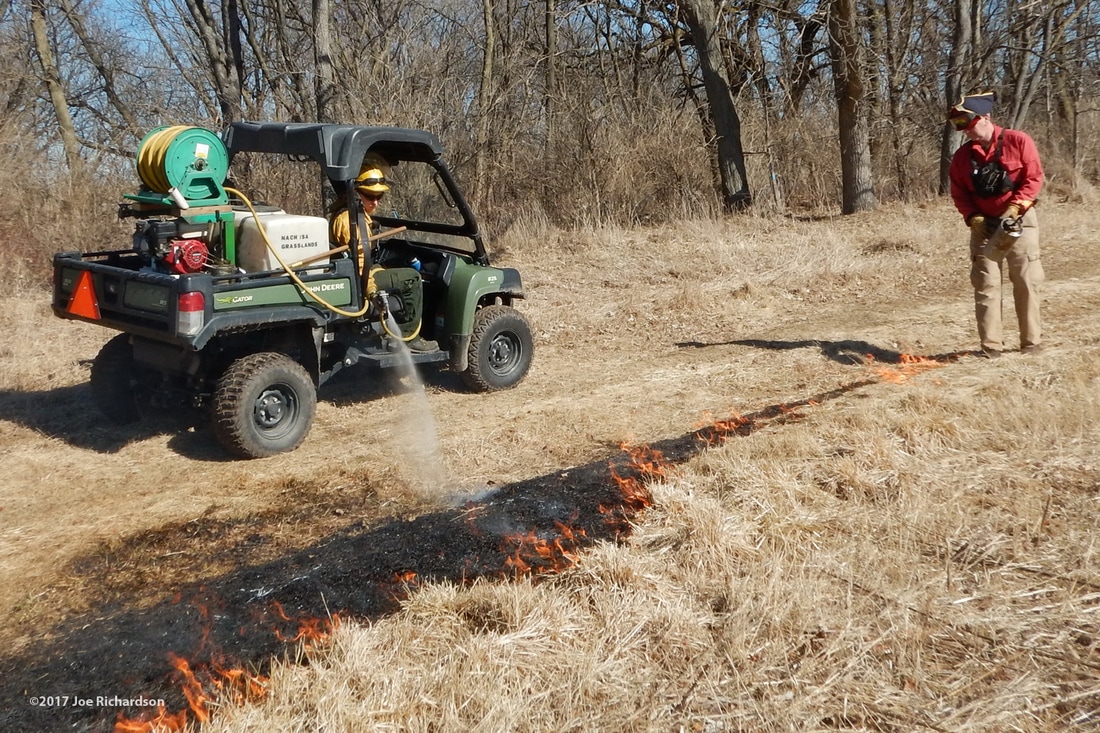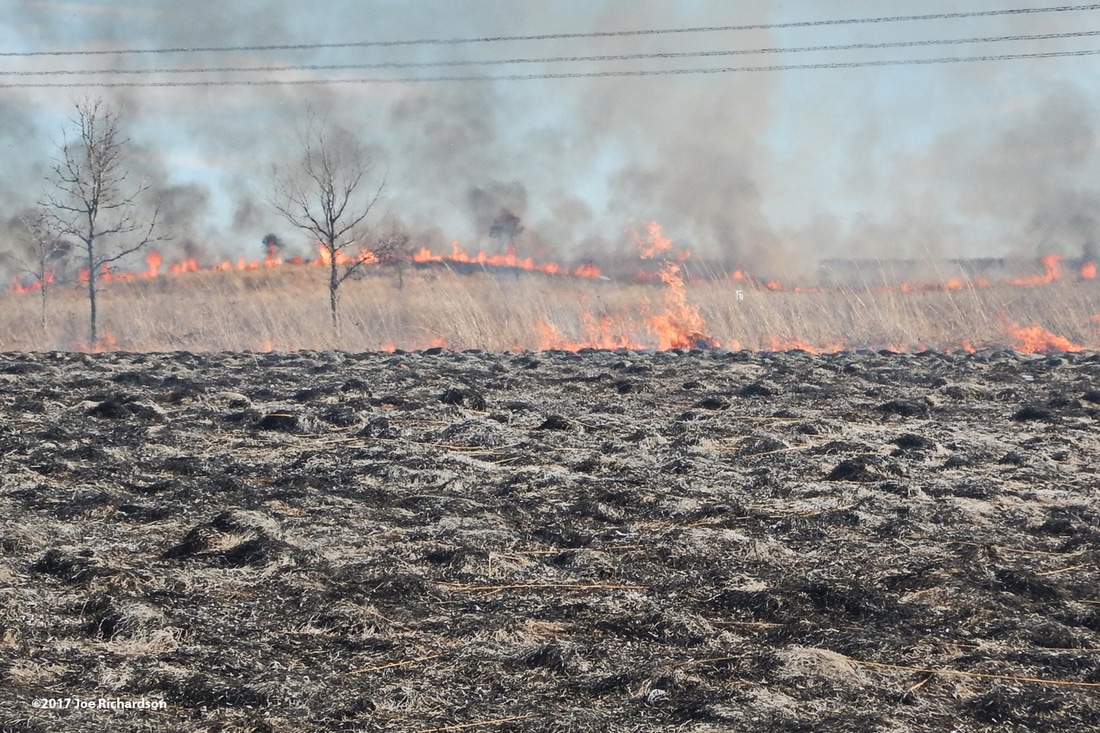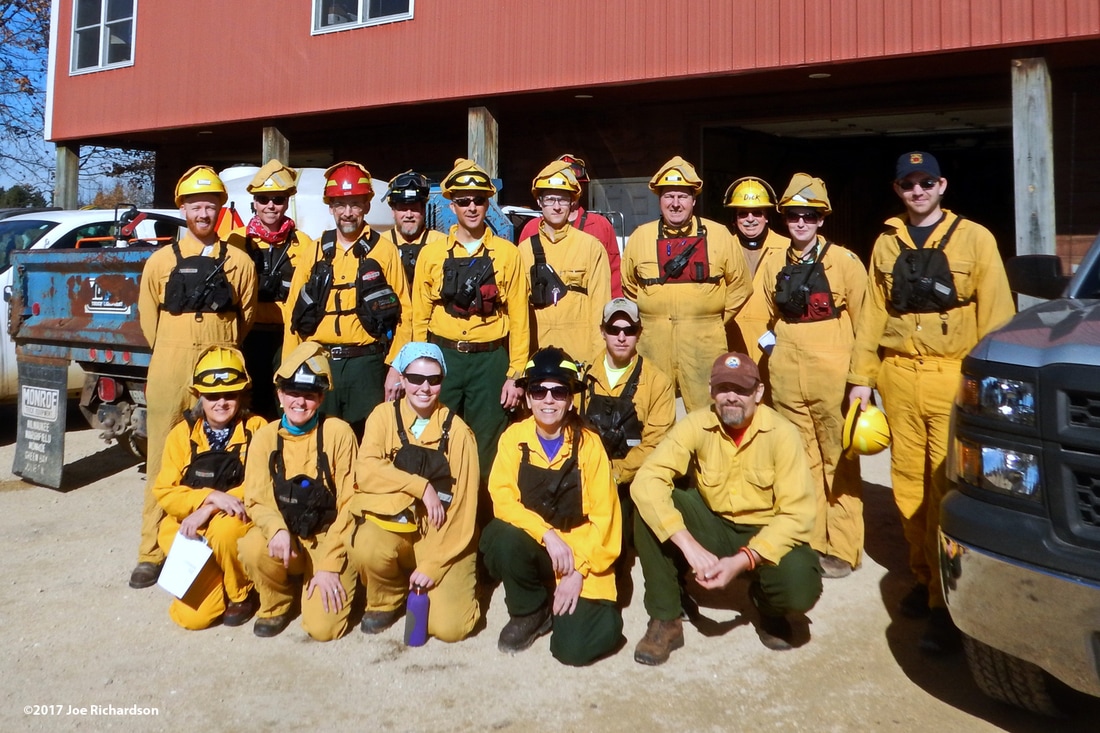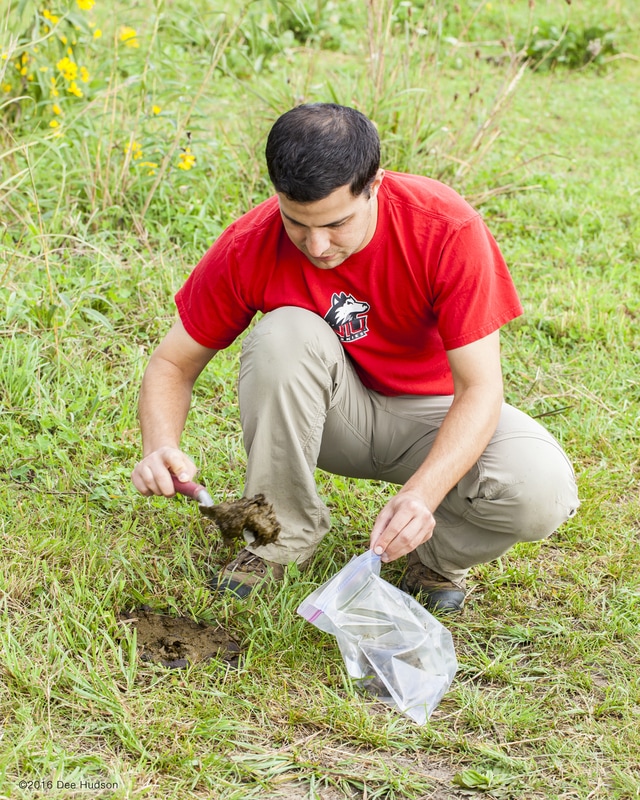|
The unseasonably warm weather created a flurry of activity to prepare the fire equipment in anticipation of the weekend's controlled burn. Nachusa burns typically begin in March. With the staff committed to speaking engagements, much of the prep work fell on long–term and dedicated volunteers, Dave Crites and Mike Carr. This past week, the men worked hard and swiftly to prepare for the possible weekend burns, loading all the various equipment and pumps to the vehicles. The burn begins, as the crew uses drip torches to ignite the grass. Water pumpers follow the igniters and extinguish any fire that burns back toward fire breaks. The crew has the fire well underway. Crew members dedicated to fire suppression, put out any unwanted fire, such as around this brush pile (it will be burned later, when there is more time to watch over it). A dust devil was observed during the burn. What causes a dust devil? McKinnon (2014) explains the interesting science:
The controlled burn is typically set in a "ring" by starting at one point and sending two crews in opposite directions, working into the wind. Near the end, the blackened area is wide enough to allow the two crews to meet up in the middle of the wind side. All the "sides" of fire meet up, and with no more fuel, the flames go out! After the burn is complete, the Project Director leads a debriefing to go over the events of the day. What did we do well? Where can we improve? Here is a short video detailing some typical events that occur during a controlled burn at Nachusa. For more information, visit Nachusa's webpage about controlled burns. Today's author is Dee Hudson. Joe Richardson, Charles Larry, Kirk Hallowell, and Bill Kleiman provided the images for this post; John Schmadeke created the video. References
McKinnon, Mika, (March 30, 2014). Science of the Fiery Dust Devil Spawned by a Controlled Burn
0 Comments
By Dr. Nick Barber The bison reintroduction has been exciting for everyone involved with Nachusa—staff and stewards, volunteers and visitors, and especially scientists. The project provides a unique opportunity to measure the impacts of these animals and their actions on the entire restored prairie ecosystem. I’m fortunate to be part of a small army of researchers and students working closely with Nachusa personnel to understand how bison influence plants, animals, and other organisms. Anyone who has had the opportunity to spend time within the bison units over the past 2 years has undoubtedly seen evidence of these giant herbivores: dung! In addition to grazing on plants and wallowing in dirt, bison play an important role in nutrient cycling by depositing concentrated piles of plant material and nutrients around the prairie. Across the landscape, this may provide hotspots of growth for some plants, adding to the overall diversity at Nachusa. An inconspicuous group of insects help to carry out this nutrient–cycling process. Dung beetles feed on animal waste, and many species collect dung as a food source for their offspring. Some species famously form it into spheres, and roll these “dung balls” away to bury and deposit eggs. Other species tunnel below the dung patty, building chambers where dung is stored and beetle larvae can develop. And some species are “dwellers” who simply dive in to fresh dung and start to feast, laying eggs along the way. When these eggs hatch, the larvae feed, pupae, and emerge as adults, completing their entire metamorphosis in a single patty before heading off to mate and start the process over again in fresh patty. Burying small bits of dung in the soil helps make nutrients accessible to plant roots. In the soil, microorganisms like bacteria and fungi convert organic materials into inorganic forms available to plants. This can represent a significant amount of the nutrients. As dung dries, much of the nitrogen can be lost to the air as ammonia volatilizes. This is why dung beetles are important for ranching: every bit of nutrients back in the soil rather than lost to the atmosphere means more fodder for livestock. So it was a reasonable assumption that the dung beetle community at Nachusa would respond positively to the introduction of several dozen large, dung-producing herbivores to the prairie. I credit Dr. Ken McCravy from WIU for first suggesting that we should investigate these communities. Over the past two years, with support from the Friends of Nachusa Grasslands, I have been working with NIU students to survey the dung beetles to determine which species are present and how their abundances differ between sites with and without bison. We use pitfall traps, baited with fresh bison dung, to collect beetles that are later pinned and identified under a microscope in my lab at NIU. Our preliminary results are exciting: we have documented at least seven species, including rollers, tunnelers, and dwellers. The two most common species are Onthophagus hecate, a widespread species, and Onthophagus knausi, a uncommon species whose range extends west and south through Kansas, Oklahoma, and Texas. The other species are much less common but include the large, blue-black Geotrupes opacus and the spectacular rainbow scarab, Phanaeus vindex. As a preliminary result, the presence of bison doesn’t seem to have a big effect on abundance, as some bison-free sites have high numbers of beetles. But this may not be surprising given how mobile these insects are. They can fly and specialize in seeking out their preferred food. Cattle pastures surrounding Nachusa likely provide population sources as well. Over the next two years, we will be investigating these dung beetle communities in more detail. A Master’s student at NIU will be combining observations of dung decomposition with beetle measurements to understand how different species contribute to dung processing. Ultimately we hope to understand how the management actions that maintain high plant diversity at Nachusa (such as prescribed fire and grazing) affect beetle communities and their ability to process dung. Keep an eye on fresh dung patties and you may see these small but fascinating insects carrying out some of the invaluable “dirty work” that keeps the prairie ecosystem healthy and biodiverse! Nick Barber is an assistant professor in the Department of Biological Sciences at Northern Illinois University. To read more about his work, visit the Barber Lab webpage. Thank you Nick, for being our guest blogger this week!
|
Blog CoordinatorDee Hudson
I am a nature photographer, a freelance graphic designer, and steward at Nachusa's Thelma Carpenter Prairie. I have taken photos for Nachusa since 2012. EditorJames Higby
I have been a high school French teacher, registered piano technician, and librarian. In retirement I am a volunteer historian at Lee County Historical and Genealogical Society. Categories
All
Archives
January 2024
|
CONNECT WITH US |
|




















 RSS Feed
RSS Feed